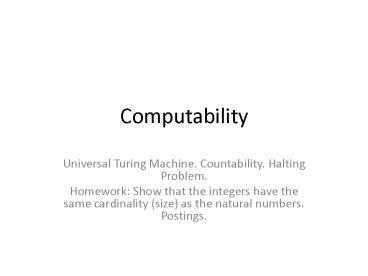Computability - PowerPoint PPT Presentation
Title:
Computability
Description:
Computability Universal Turing Machine. Countability. Halting Problem. Homework: Show that the integers have the same cardinality (size) as the natural numbers. – PowerPoint PPT presentation
Number of Views:46
Avg rating:3.0/5.0
Title: Computability
1
Computability
- Universal Turing Machine. Countability. Halting
Problem. - Homework Show that the integers have the same
cardinality (size) as the natural numbers.
Postings.
2
Enumerator definition?
- Need to describe parts
- Transition function
- Output
3
Universal Turing Machine
- is a Turing Machine U in which the input comes
in two parts - Description/encoding of a Turing Machine M and
- Input string w
- U (ltM,wgt) is the same as M(ltwgt)
- Accepts if M accepts w
- Rejects if M rejects w
- Loops (fails to halt) if M fails to halt
4
Claim
- We can build such a U.
- Use 3 tapes.
- For initial information (definition of M and w)
- Hold status info for which state of M and
position in w - Working tape.
- First step is to set up tape 2 with initial state
and starting position and tape 3 with w. - Operation states of U use status to simulate M
operating on tape 3.
5
Stored program
- The notion of a universal Turing machine MAY
have helped in development of stored programs. - Note calculators do not have stored programs.
- The notion of a program being treated as data,
such as done when compiling or interpreting code,
was critical in the development of computers. - Topic research idea.
6
Last class
- Atm ltM,wgtM is a TM and w is a string and M
accepts w is - Turing recognizable because U recognizes it.
- May not halt because U only simulates M and M
may not halt. - But maybe another technique could be better than
M... - This is the halting problem
7
Digression infinite sets
- How do we compare infinite sets?
- Certainly,
- the counting numbers (1, 2, 3, ) are contained
in - the integers( 0, 1, 2, , -1, -2, ) are
contained in - the rationals (all numbers of the form p/q, where
p and q are integers) are contained in - the reals (numbers with decimals, possibly
infinite)
8
New concept cardinality
- Note Sipser uses size.
- Georg Cantor (1873) noticed that two finite sets
are the same size if the elements in each can be
paired. - Definition Two sets A B have the same
cardinality (size?) if there exists a function - f A ? B, that is 1 to 1 and onto1 to 1 means
if f(a) f(b) then ab. - onto means if b is in B, then there is an a
such that f(a) b
9
Example
- The natural numbers N are the same cardinality as
the even natural numbers! - Let f(n) 2 n. This is 1 to 1 and onto!
10
Countable
- A set is countable if it is finite OR if it has
the same cardinality as the natural numbers. - My words a set of countable if you can put all
the elements in a list (describe the list in the
case of an infinite set).
11
Rationals are countable!
- Construct a table. Redundant numbers will be
removed. Red line represents the list. - 1/1 ½ 1/3 ¼ 1/5
- 2/1 2/2 2/3 2/4 2/5 .
- 3/1 3/2 3/3 ¾ 3/5
12
Are the reals countable?
- Proof by contradiction.
- Suppose there is a list
- 1.0000000000
- 3.14159
- .111222333
- .
- Let x by a number such with whole number 1 and
number at ith position from decimal point is NOT
equal to the ith position of the ith element on
the list. Avoid 0 or 9. Then x is NOT on the
list!
13
Diagonalization
- General technique, possible only if there is a
list.
14
Halting Problem
- Atm ltM,wgtM is a TM and w is a string and M
accepts w is undecidable. - Proof assume that H is a decider for Atm. Define
a new Turing Machine D as follows - D(ltMgt) run H on (M, ltMgt). Output reject if H
accepts and accept if H rejects. (Like the
diagonalization). Claim if H exists, then we can
build D that calls it as a subroutine.
15
Proof, continued
- Then, what is D(ltDgt)? Run H(D, ltDgt). By
definition, this is D running on ltDgt. If H
returns accept (D running on ltDgt accepts) then H
rejects. If it rejects, then accept. - Contradiction!
- Contradiction arises because H could not be built
to be used by D.
16
Practical implications
- Before there were computers, mainly stored
program computers, there is a result that there
can't be full-proof debuggers/checkers.
17
Homework
- Produce proof that the integers are countable.
- Posting on practical implications of Halting
problem. - Posting on history / origin of stored program
concepts.































